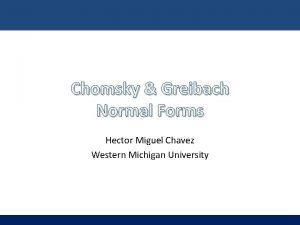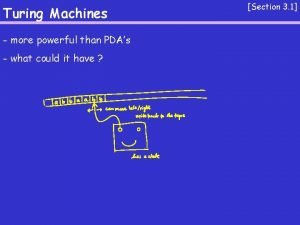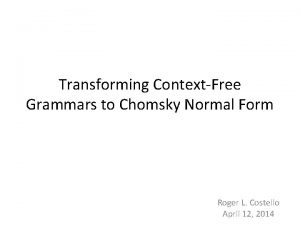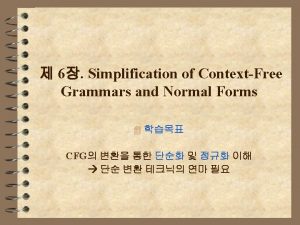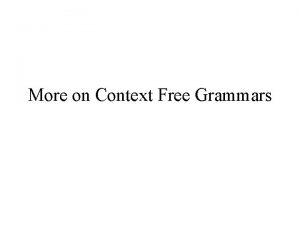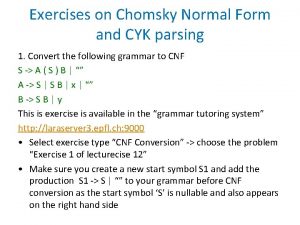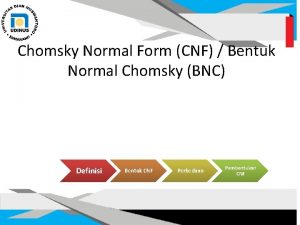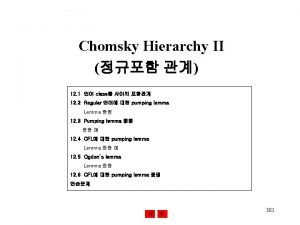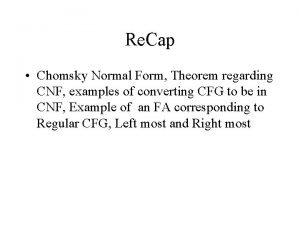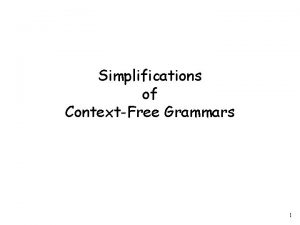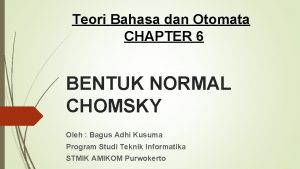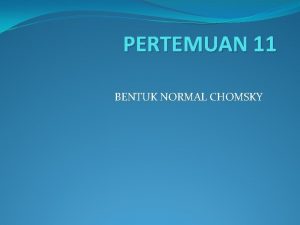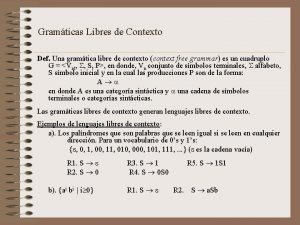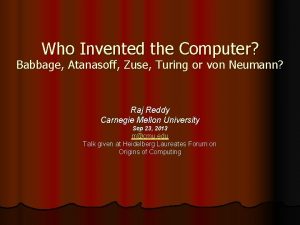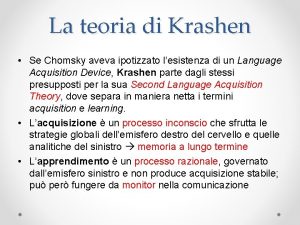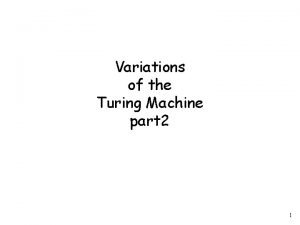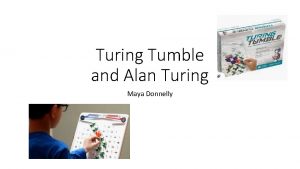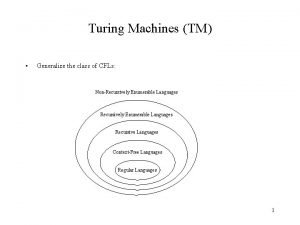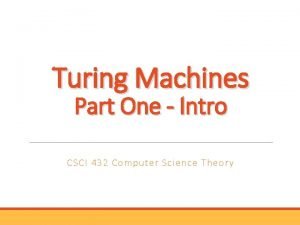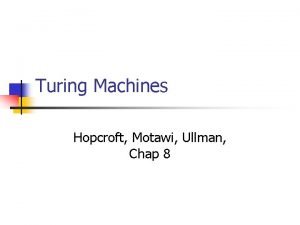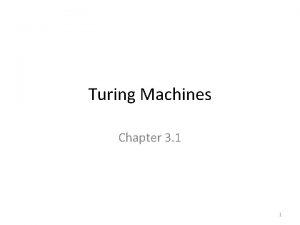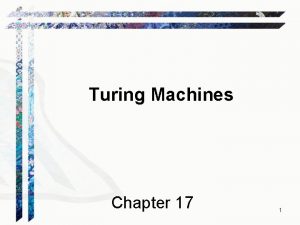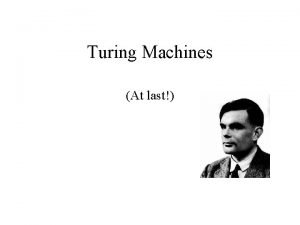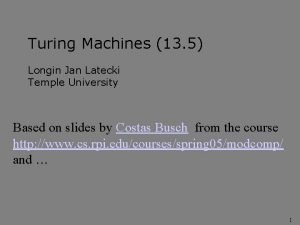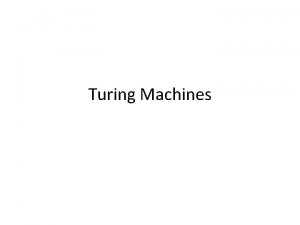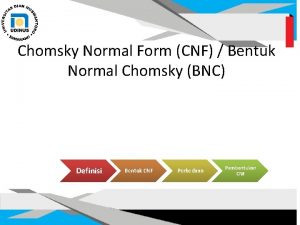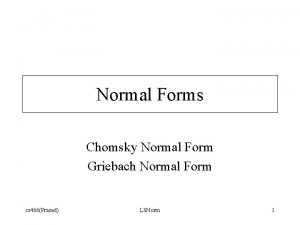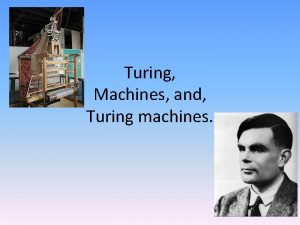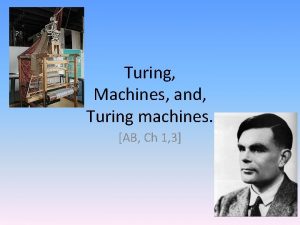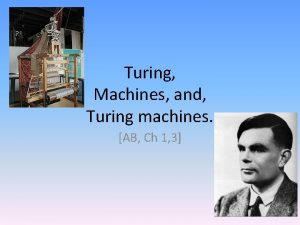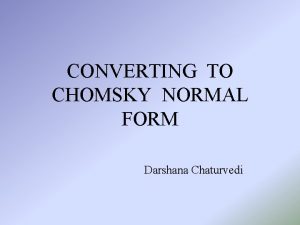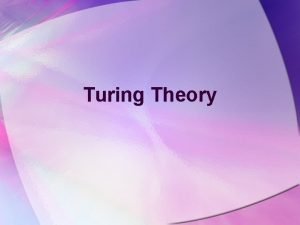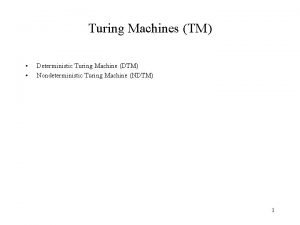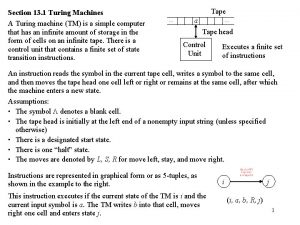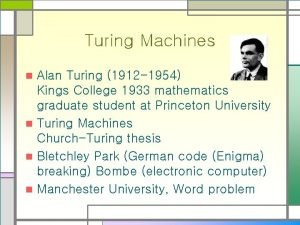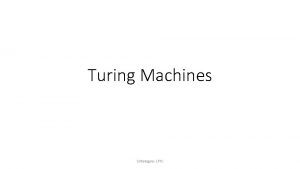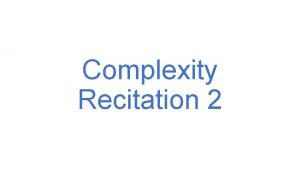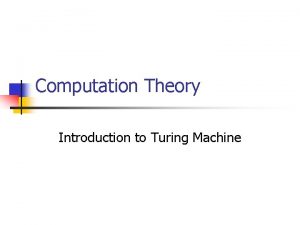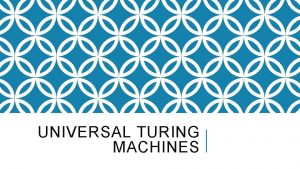Chomsky Normal Form and TURING MACHINES CHOMSKY NORMAL































- Slides: 31

Chomsky Normal Form and TURING MACHINES

CHOMSKY NORMAL FORM A context-free grammar is in Chomsky normal form if every rule is of the form: A → BC B and C aren’t start variables A→a a is a terminal S→ε S is the start variable Any variable A (except the start variable) can only generate strings of length > 0

CHOMSKY NORMAL FORM A context-free grammar is in Chomsky normal form if every rule is of the form: A → BC B and C aren’t start variables A→a a is a terminal S→ε S is the start variable S → 0 S 1 S → TT T→ε S 0 → TU | TV | ε T→ 0 U → SV S → TU | TV V→ 1

Theorem: If G is in CNF, w L(G) and |w| > 0, then any derivation of w in G has length 2|w| - 1 Proof (by induction on |w|): Base Case: If |w| = 1, then any derivation of w must have length 1 (S → a) Inductive Step: Assume true for any string of length at most k ≥ 1, and let |w| = k+1 Since |w| > 1, derivation starts with S → AB So w = xy where A * x, |x| > 0 and B * y, |y| > 0 By the inductive hypothesis, the length of any derivation of w must be 1 + (2|x| - 1) + (2|y| - 1) = 2(|x| + |y|) - 1

Theorem: Any context-free language can be generated by a context-free grammar in Chomsky normal form “Can transform any CFG into Chomsky normal form”

Theorem: Any context-free language can be generated by a context-free grammar in Chomsky normal form Proof Idea: 1. Add a new start variable 2. Eliminate all A ε rules. Repair grammar 3. Eliminate all A B rules. Repair 4. Convert A u 1 u 2. . . uk to A u 1 A 1, A 1 u 2 A 2, . . . If ui is a terminal, replace ui with Ui and add Ui ui

2. Add Remove allstart A →variable ε rules S 0 1. a new (where is not and add. Athe rule. SS 0)0 → S For each occurrence of A on right hand side of a rule, add a new rule with the occurrence deleted If we have the rule B → A, add B → ε, unless we have previously removed B → ε 3. Remove unit rules A → B Whenever B → w appears, add the rule A → w unless this was a unit rule previously removed S 0 → S S → 0 S 1 S → T#T S→T T→ε S → T# S → #T S→# S→ε S 0→ → 01 0 S 1 S 0 → ε

4. Convert all remaining rules into the proper form: S 0 → A 1 A 2 S 0 → 01 S 0 → A 1 A 3 A 1 → 0 S → 01 A 2 → SA 3 S → A 1 A 3 S 0 → 0 S 1 A 3 → 1 S 0 → ε S 0 → 0 S 1 S 0 → T#T S 0 → T# S 0 → #T S 0 → # S 0 → 01 S → 0 S 1 S → T#T S → T# S → #T S→# S → 01

Convert the following into Chomsky normal form: A → BAB | B | ε B → 00 | ε S 0 → A | ε A → BAB | BB | AB | BA B → 00 S 0 → BAB | 00 | BB | AB | BA | ε A → BAB | 00 | BB | AB | BA B → 00 S 0 → BC | DD | BB | AB | BA | ε, C → AB, A → BC | DD | BB | AB | BA , B → DD, D → 0

TURING MACHINE FINITE STATE q 10 CONTROL AI N P U T INFINITE TAPE

read write move → , R 0 → 0, R qreject 0 → 0, R → , L qaccept

read write 0 → 0, R → , R move → , R 0 → 0, R → , L qaccept

TMs VERSUS FINITE AUTOMATA TM can both write to and read from the tape The head can move left and right The input doesn’t have to be read entirely, and the computation can continue after all the input has been read Accept and Reject take immediate effect

Definition: A Turing Machine is a 7 -tuple T = (Q, Σ, Γ, , q 0, qaccept, qreject), where: Q is a finite set of states Σ is the input alphabet, where Σ Γ is the tape alphabet, where Γ and Σ Γ : Q Γ → Q Γ {L, R} q 0 Q is the start state qaccept Q is the accept state qreject Q is the reject state, and qreject qaccept

CONFIGURATIONS 11010 q 700110 corresponds to: q 7 1 1 0 0 0 1 1 0

A TM recognizes a language iff it accepts all and only those strings in the language A language L is called Turing-recognizable or recursively enumerable iff some TM recognizes L A TM decides a language L iff it accepts all strings in L and rejects all strings not in L A language L is called decidable or recursive iff some TM decides L

A language is called Turing-recognizable or recursively enumerable (r. e. ) if some TM recognizes it A language is called decidable or recursive if some TM decides it r. e. languages recursive languages

Theorem: If A and A are r. e. then A is recursive Given: a TM that recognizes A and a TM that recognizes A, we can build a new machine that decides A

2 n {0 |n≥ 0} PSEUDOCODE: 1. Sweep from left to right, cross out every other 0 2. If in stage 1, the tape had only one 0, accept 3. If in stage 1, the tape had an odd number of 0’s, reject 4. Move the head back to the first input symbol. 5. Go to stage 1.

x → x, L 0 → 0, L 2 n {0 |n≥ 0} q 2 → , R → , L x → x, R q 0 x → x, R → , R qreject x → x, R q 1 0 → , R 0 → x, R q 3 0 → 0, R 0 → x, R qaccept q 4 → , R x → x, R

x → x, L q 0000 0 → 00, L 2 n {0 |n≥ 0} xq 300 → , R → , L x → x, R q 0 x → x, R → , R qreject q 1000 q 2 x 0 qx 4→ 0 x, R q 1 0 → , R x 0 xq 3 q 0 → x, R 3 x 0 q 2 x xq 0 x 0, R 0 2→ q 2 x 0 x qq 24 x 0 x qaccept → , R x → x, R

C = {aibjck | k = ij, and i, j, k ≥ 1} PSEUDOCODE: 1. If the input doesn’t match a*b*c*, reject. 2. Move the head back to the leftmost symbol. 3. Cross off an a, scan to the right until b. Sweep between b’s and c’s, crossing off one of each until all b’s are crossed off. 4. Uncross all the b’s. If there’s another a left, then repeat stage 3. If all a’s are crossed out, Check if all c’s are crossed off. If yes, then accept, else reject.

C = {aibjck | k = ij, and i, j, k ≥ 1} aabbbcccccc xayyyzzzccc xabbbzzzccc xxyyyzzzzzz

MULTITAPE TURING MACHINES FINITE STATE CONTROL : Q Γk → Q Γk {L, R}k

Theorem: Every Multitape Turing Machine can be transformed into a single tape Turing Machine 1 0 0 FINITE STATE CONTROL . 1 0 0 # . #

Theorem: Every Multitape Turing Machine can be transformed into a single tape Turing Machine 1 0 0 FINITE STATE CONTROL 1 . 0 0 # . #

THE CHURCH-TURING THESIS Intuitive Notion of Algorithms EQUALS Turing Machines

We can encode a TM as a string of 0 s and 1 s n states start state reject state 0 n 10 m 10 k 10 s 10 t 10 r 10 u 1… m tape symbols (first k are input symbols) accept state blank symbol ( (p, a), (q, b, L) ) = 0 p 10 a 10 q 10 b 10 ( (p, a), (q, b, R) ) = 0 p 10 a 10 q 10 b 11

Similarly, we can encode DFAs, NFAs, CFGs, etc. into strings of 0 s and 1 s So we can define the following languages: ADFA = { (B, w) | B is a DFA that accepts string w } ANFA = { (B, w) | B is an NFA that accepts string w } ACFG = { (G, w) | G is a CFG that generates string w }

ADFA = { (B, w) | B is a DFA that accepts string w } Theorem: ADFA is decidable Proof Idea: Simulate B on w ANFA = { (B, w) | B is an NFA that accepts string w } Theorem: ANFA is decidable ACFG = { (G, w) | G is a CFG that generates string w } Theorem: ACFG is decidable Proof Idea: Transform G into Chomsky Normal Form. Try all derivations of length 2|w|-1

Read Chapter 3 of the book for next time
 Alan turing julius mathison turing
Alan turing julius mathison turing Chomsky and greibach normal form
Chomsky and greibach normal form Pda is less powerful than turing machines
Pda is less powerful than turing machines Chomsky normal form calculator
Chomsky normal form calculator Chomsky normal form
Chomsky normal form Chomsky normal form 설명
Chomsky normal form 설명 Chomsky normal form exercises
Chomsky normal form exercises Contoh soal bentuk normal chomsky
Contoh soal bentuk normal chomsky Chomsky normal form 설명
Chomsky normal form 설명 Chomsky normal form examples
Chomsky normal form examples Chomsky normal form
Chomsky normal form Bentuk normal chomsky
Bentuk normal chomsky Contoh bentuk normal chomsky
Contoh bentuk normal chomsky Jelaskan bentuk normal chomsky
Jelaskan bentuk normal chomsky Gramática libre de contexto ejercicios resueltos
Gramática libre de contexto ejercicios resueltos Present progressive interrogative
Present progressive interrogative Progress on babbage computer
Progress on babbage computer Alan turing computing machinery and intelligence
Alan turing computing machinery and intelligence Chomsky vs piaget
Chomsky vs piaget Stephen krashen metodo
Stephen krashen metodo Chapter 4 section 1 work and machines answer key
Chapter 4 section 1 work and machines answer key Alanturingalanturing
Alanturingalanturing Turing macine
Turing macine Maya donnelly
Maya donnelly Halting problem of turing machine
Halting problem of turing machine Turing machine examples
Turing machine examples Ullman turing
Ullman turing Church turing hypothesis
Church turing hypothesis Turing machine for wcw
Turing machine for wcw Turing machine 7 tuple
Turing machine 7 tuple Arnold murray turing
Arnold murray turing Turing machine examples
Turing machine examples

